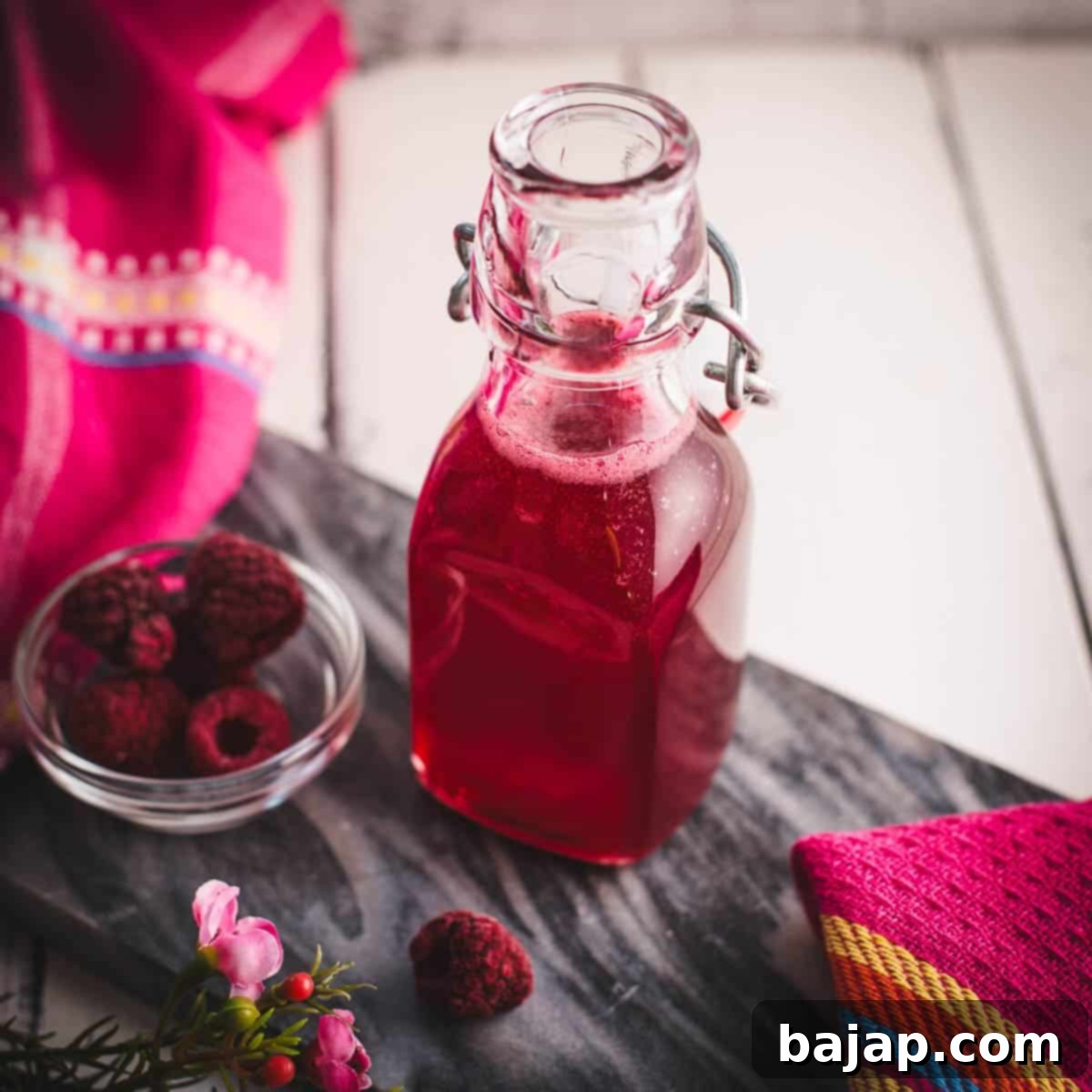DIY No-Cook Raspberry Syrup: Easy Cold-Process Recipe for Cocktails & Drinks
Craving the vibrant, sweet-tart taste of fresh raspberries in your drinks and desserts without heating up your kitchen? You’ve come to the right place! Today, we’re diving into the second of three fantastic methods for crafting exquisite raspberry syrup, perfect for elevating your favorite cocktails, mocktails, and culinary creations. While we previously explored the quickest stovetop route, this particular technique offers a delightful alternative for those who prefer a hands-off approach.
This method, often referred to as a “cold-process” or “no-cook” infusion, requires a bit more patience but promises an exceptionally deeply flavorful outcome. It involves preparing your homemade raspberry syrup in a preserving jar and allowing it to slowly infuse in the refrigerator for three to five days. This gentle extraction process coaxes out the purest essence of the raspberries, resulting in a syrup that’s remarkably fresh, bright, and intensely fruity.
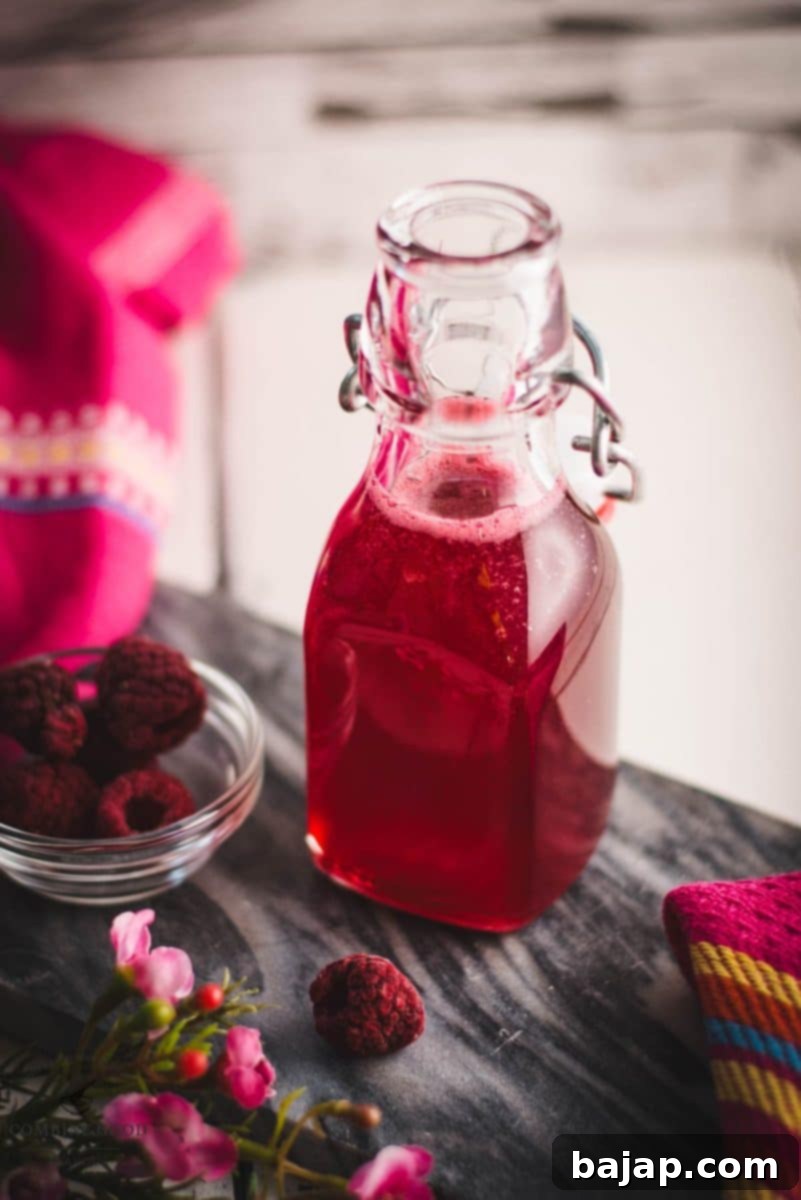
This no-cook raspberry syrup method truly shines brightest during the warm summer months when the last thing you want is to be standing over a hot stove. Despite the short wait for the raspberry syrup to mature and develop its full flavor, the sheer relief of avoiding the summer heat in your kitchen is invaluable. You’ll simply combine your ingredients, seal, and let the refrigerator do all the work, extracting every drop of deliciousness from the fresh fruit.
Your patience will be handsomely rewarded with a fragrant, deeply colored, and exquisitely flavorful raspberry syrup. It’s the perfect ingredient for crafting an array of refreshing beverages, such as a crisp raspberry lemon drop martini, a tantalizing raspberry gin and tonic, or even a simple, elegant raspberry soda. This homemade syrup also makes a fantastic topping for pancakes, ice cream, yogurt, or as a vibrant addition to baked goods. Get ready to embrace the pure, natural taste of summer with this incredibly easy and rewarding cold-process fruit syrup!
🥘 Key Ingredients for Your Homemade Raspberry Syrup
Crafting this delightful no-cook raspberry syrup requires only two essential ingredients, ensuring that the natural flavor of the fruit remains the star. Here’s what you’ll need and why:
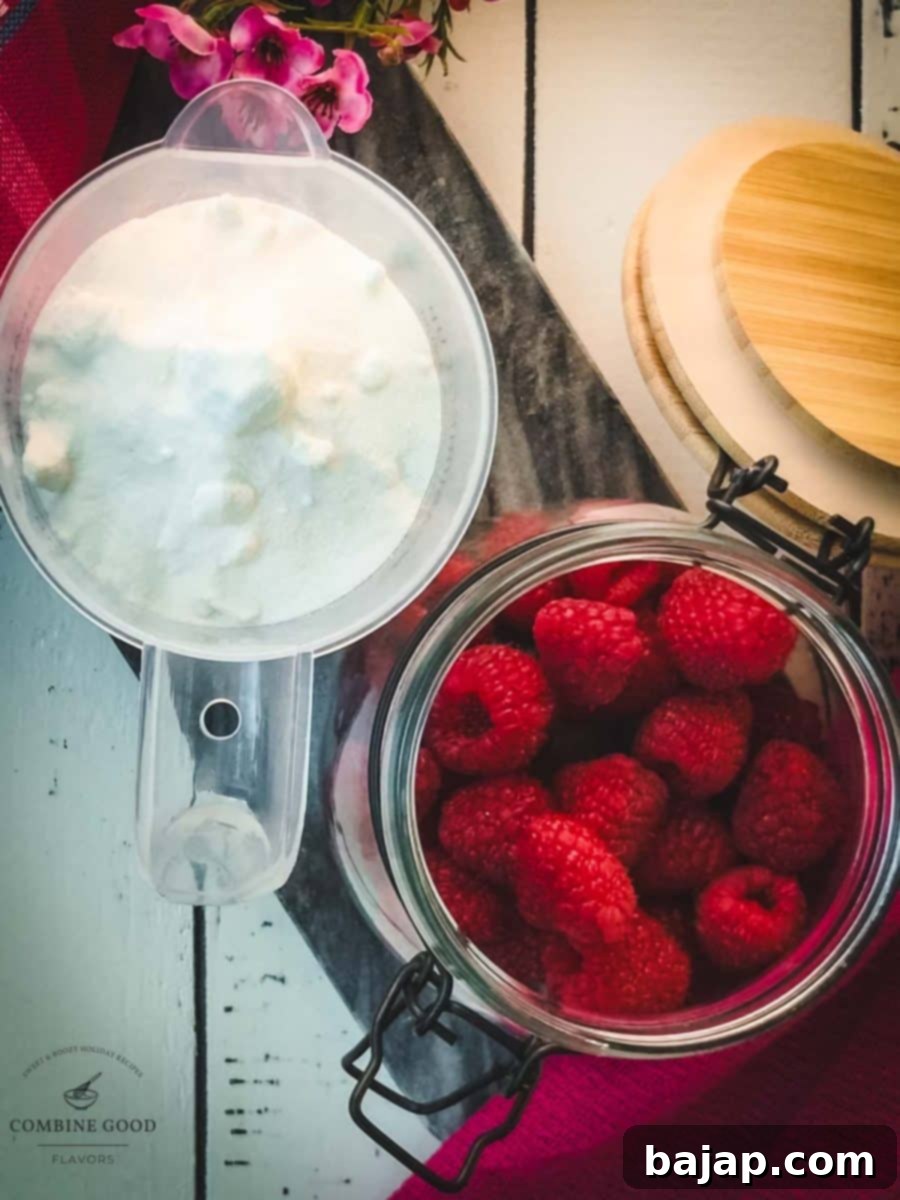
- Fresh Raspberries: The heart of your syrup! Opt for the ripest, most fragrant raspberries you can find to infuse your homemade syrup with an unparalleled burst of vibrant, fruity essence. When choosing, look for berries that are plump, brightly colored, and free from mold. You will literally fill your mason jar to the brim with these luscious gems, ensuring maximum flavor extraction. While fresh is always best for this method, frozen raspberries can also be used, though they might yield a slightly different texture and color. If using frozen, let them thaw completely before combining with sugar.
- Granulated Sugar: For this specific no-cook raspberry syrup recipe, regular white granulated sugar is your ideal choice. Its fine, uniform texture ensures swift and even dissolution when combined with the raspberries, resulting in a velvety smooth syrup. Granulated sugar also allows the pure raspberry flavor to shine through without adding any competing notes. Avoid using brown sugar or other specialty sugars, as their distinct flavors could introduce unwanted nuances that might mask the delicate, natural taste of the raspberries. The sugar acts as both a preservative and the agent that draws out the fruit’s natural juices through osmosis, creating the syrup over time.
For precise measurements and a detailed step-by-step guide, please refer to the complete recipe card provided below.
🔪 Step-by-Step Instructions for No-Cook Raspberry Syrup
Creating this cold-process raspberry syrup is incredibly straightforward, relying on time and refrigeration to work its magic. Follow these simple steps for a truly delicious result:
Step 1: Layer Raspberries and Sugar in a Preserving Jar.
Begin by filling a clean, sterilized preserving jar (or mason jar) with fresh raspberries. Layer them gently, alternating with spoonfuls of granulated white sugar. Continue layering until the jar is almost full, leaving a small headspace at the top. The sugar will gradually draw out the natural juices from the raspberries through a process called osmosis, forming the syrup.
Step 2: Seal and Refrigerate for 3-5 Days.
Once your jar is filled, seal it tightly with an airtight lid. Place the jar in the refrigerator and let it infuse for a period of 3 to 5 days. This extended refrigeration period is crucial for the sugar to fully dissolve and for the raspberries to release their concentrated flavor and vibrant color into the syrup. Resist the urge to open it too soon!
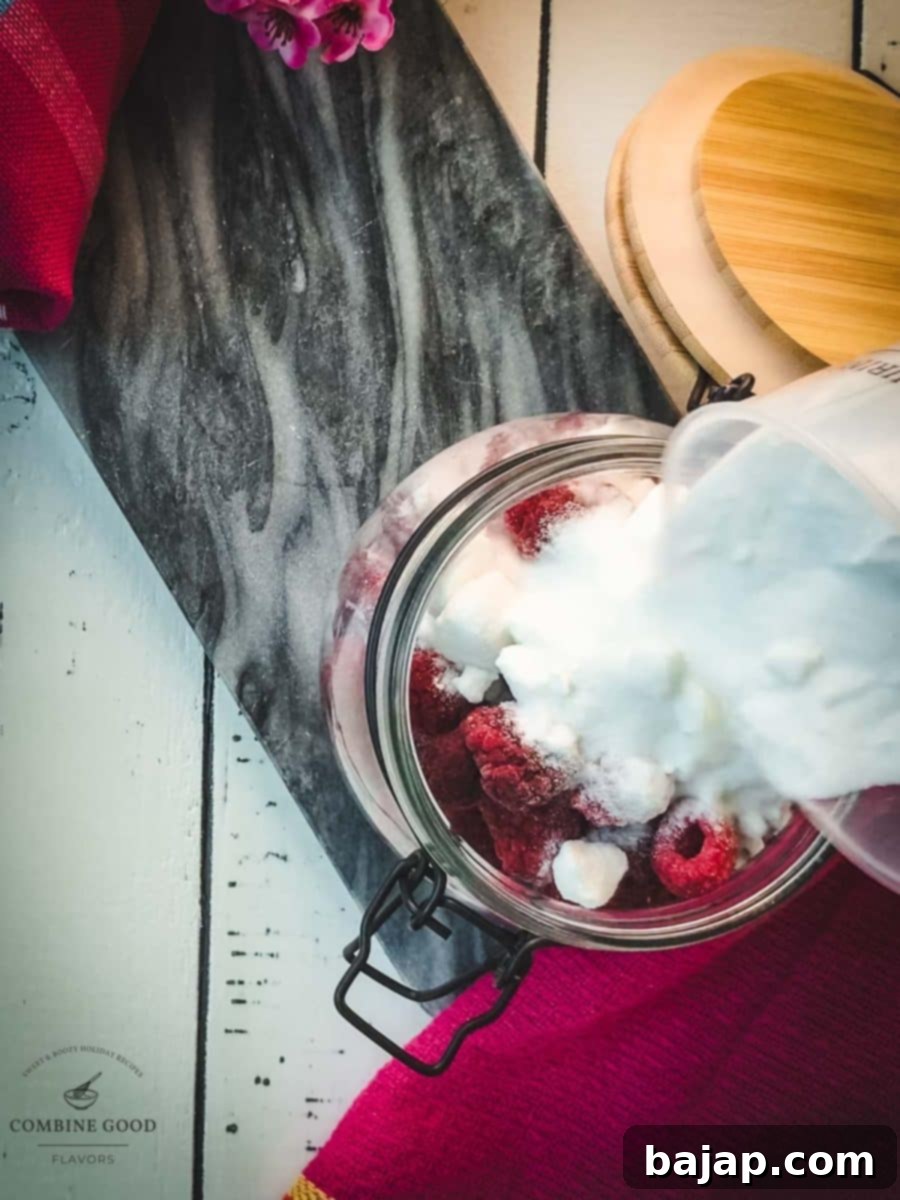
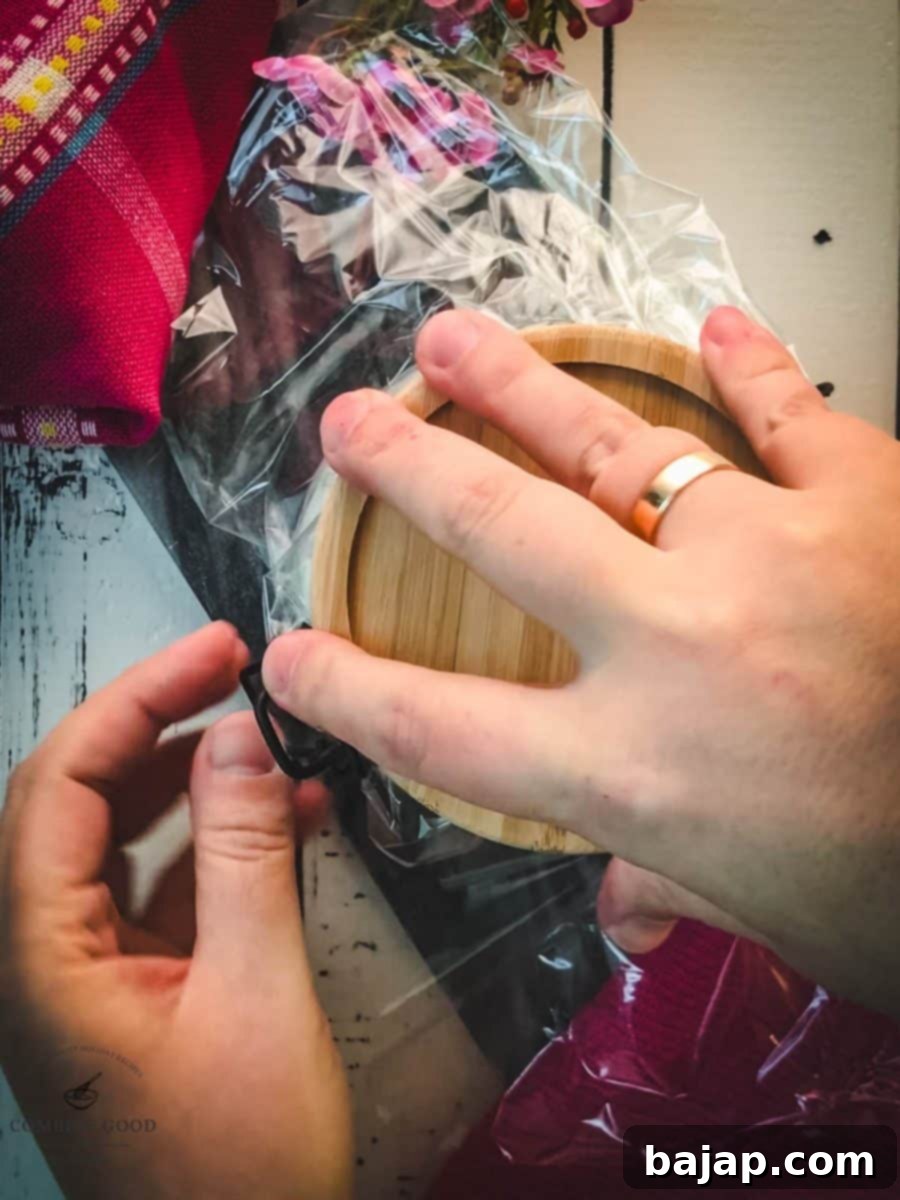
Step 3: Shake the Jar Daily for Optimal Extraction.
To aid in the sugar dissolution and flavor extraction process, gently shake the sealed jar once or twice every day. This helps redistribute the sugar and ensures that all the raspberries are continuously in contact with the forming syrup, preventing any sugar from settling at the bottom. This small effort makes a big difference in the final product’s consistency and taste.
Step 4: Optionally, Gently Squeeze Raspberries for More Juice.
After a few days of infusion, you’ll notice the raspberries have softened considerably and a rich, liquid syrup has formed. For an even more potent raspberry syrup, you can optionally open the jar and gently squeeze the softened raspberries with a clean spoon or your hands (ensuring they are thoroughly washed). This simple action helps to release any remaining juice and flavor trapped within the fruit, maximizing your yield.
Step 5: Strain the Syrup and Transfer to a Bottle for Storage.
Once the infusion period is complete and you’re satisfied with the flavor, it’s time to separate the syrup from the fruit solids. Place a fine-mesh sieve over a bowl or another clean preserving bottle. Carefully pour the contents of your jar into the sieve, allowing the luscious raspberry syrup to drip through. For a clearer syrup, you can line the sieve with a piece of cheesecloth. Gently press down on the raspberries in the sieve to extract as much liquid as possible, but avoid mashing them vigorously if you prefer a less cloudy syrup. Transfer the strained homemade raspberry syrup into a clean, airtight bottle, and it’s ready for storage.
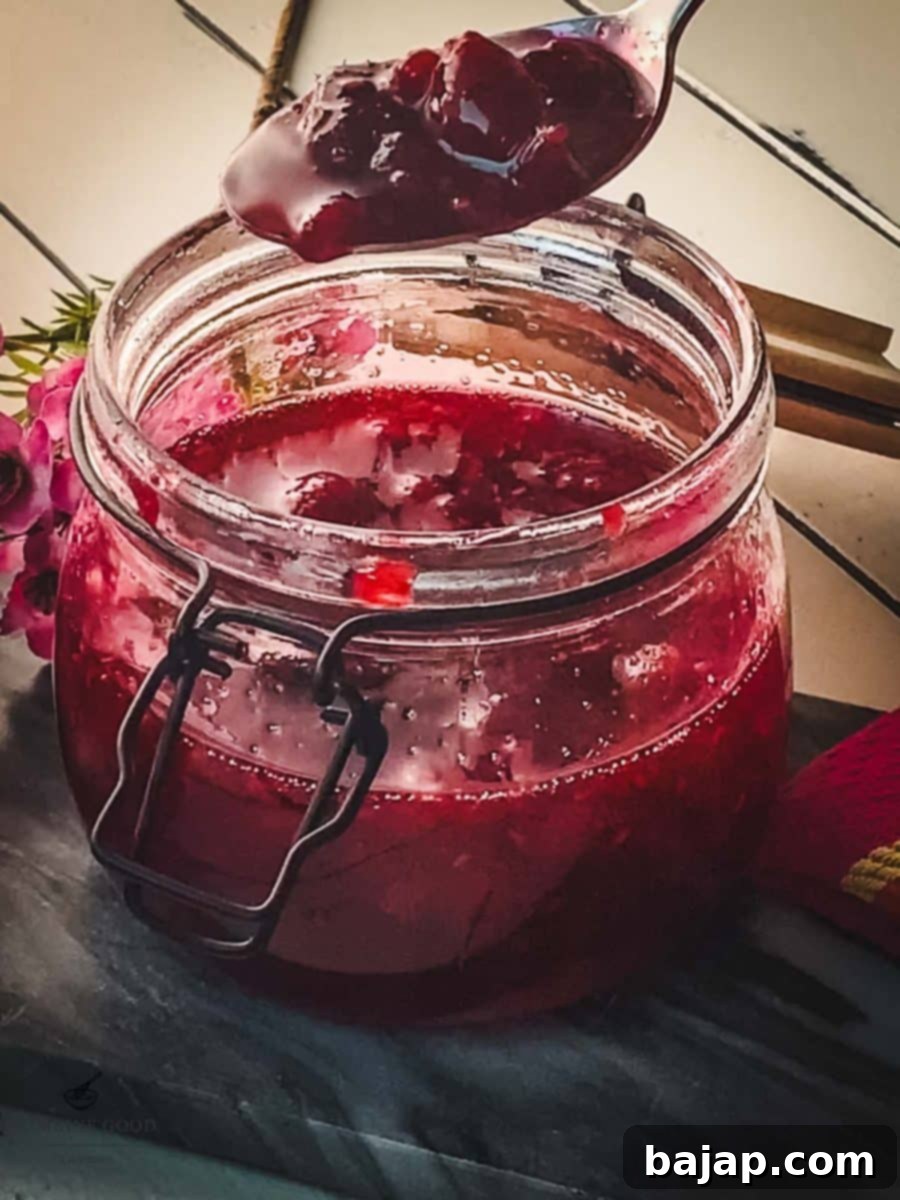
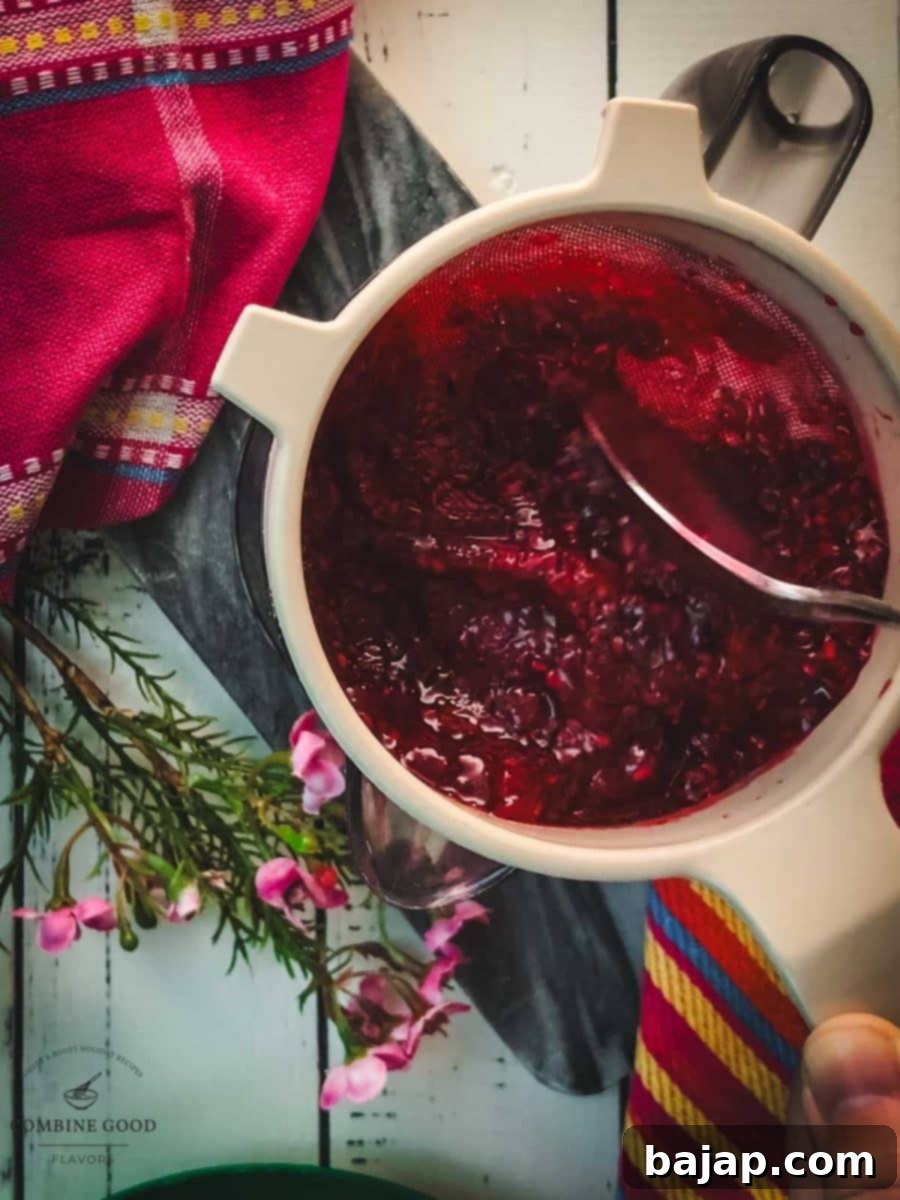
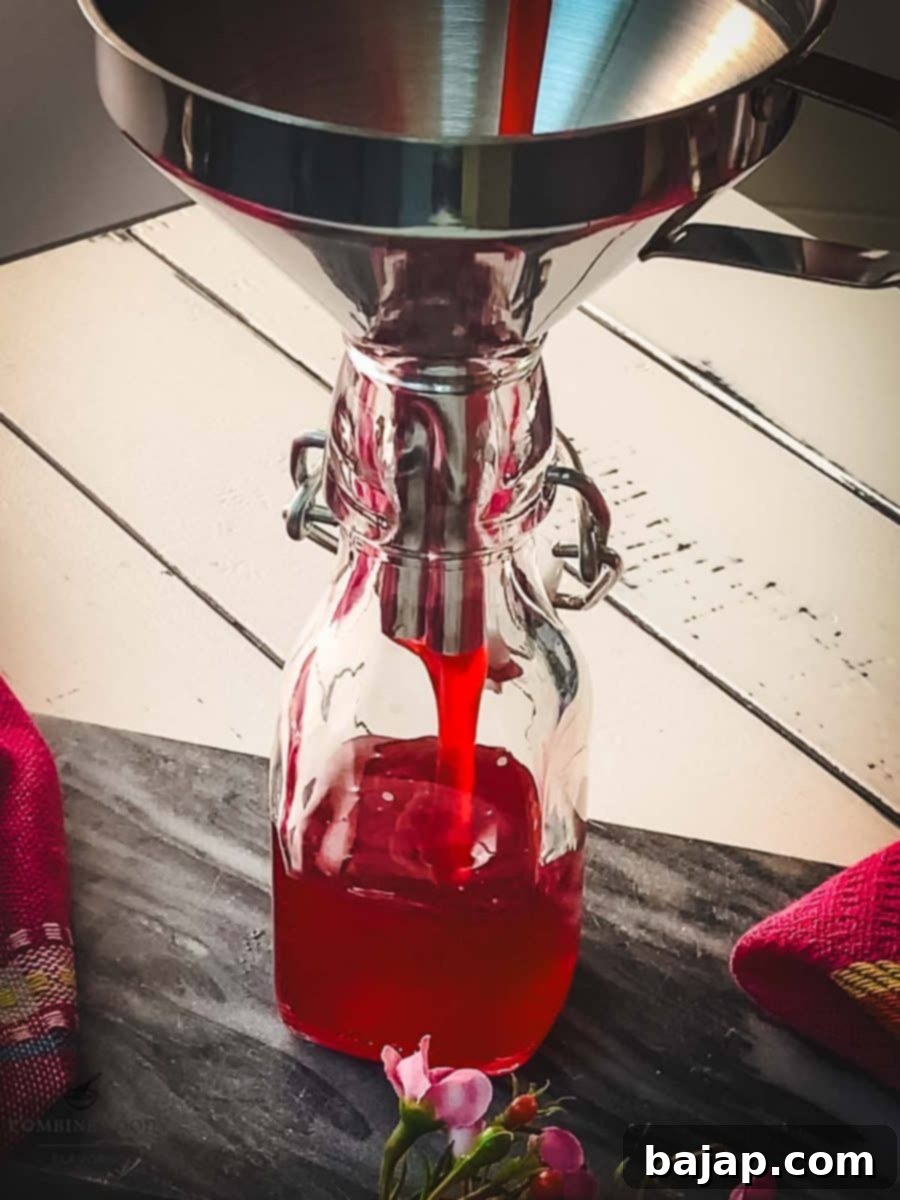
🌡️ Storage Solutions for Your No-Cook Raspberry Syrup
Proper storage is key to preserving the fresh flavor and extending the shelf life of your homemade uncooked raspberry syrup. After straining, transfer the vibrant liquid directly into a clean, sterilized, and airtight glass bottle or jar. A funnel can be incredibly helpful for a mess-free transfer. Seal the container tightly to prevent air exposure, which can lead to spoilage.
Refrigeration is essential for this no-cook fruit syrup. Stored in the refrigerator, your raspberry syrup should maintain its freshness and quality for approximately 2-3 weeks. Always check for any signs of spoilage, such as unusual odors, mold, or discoloration, before use. For longer storage, you can also consider freezing the syrup in ice cube trays or freezer-safe containers for up to 3 months. Thaw in the refrigerator before using.
🥘 Variations & Alternative Methods
While this cold-process method yields a wonderfully fresh raspberry syrup, there are other ways to enjoy this delicious fruit. If you find yourself a bit impatient or simply prefer a quicker process, you can always try our recipe for a delicious raspberry syrup that can be prepared in just 10 minutes on the stovetop. This cooked method is fantastic when you need a batch of syrup in a hurry!
You can also experiment with other fruits using the cold-process method. Berries like strawberries, blackberries, and blueberries are excellent candidates, as are sliced peaches or plums. Just ensure the fruit is ripe and clean, and maintain a similar fruit-to-sugar ratio to allow for proper syrup formation. Consider adding a zest of lemon or orange, or a sprig of fresh mint or basil to your preserving jar along with the raspberries and sugar for an added layer of aromatic complexity.
🍽 Essential Equipment You’ll Need
Making this no-cook raspberry syrup doesn’t require any fancy gadgets. Here’s a list of the basic kitchen tools that will make the process smooth and easy:
- Preserving Jar / Mason jar (10 oz or similar size): This is where the magic happens – your infusion vessel.
- Refrigerator: Essential for the cold infusion process and storage.
- Funnel: Helps in cleanly transferring the strained syrup into your storage bottle.
- Spoon: For layering ingredients and gently squeezing the fruit.
- Close-meshed Sieve: Crucial for separating the liquid syrup from the fruit solids. For an even clearer syrup, you might want to line it with cheesecloth.
- Preserving Bottle: A clean, airtight bottle for storing your finished raspberry syrup.
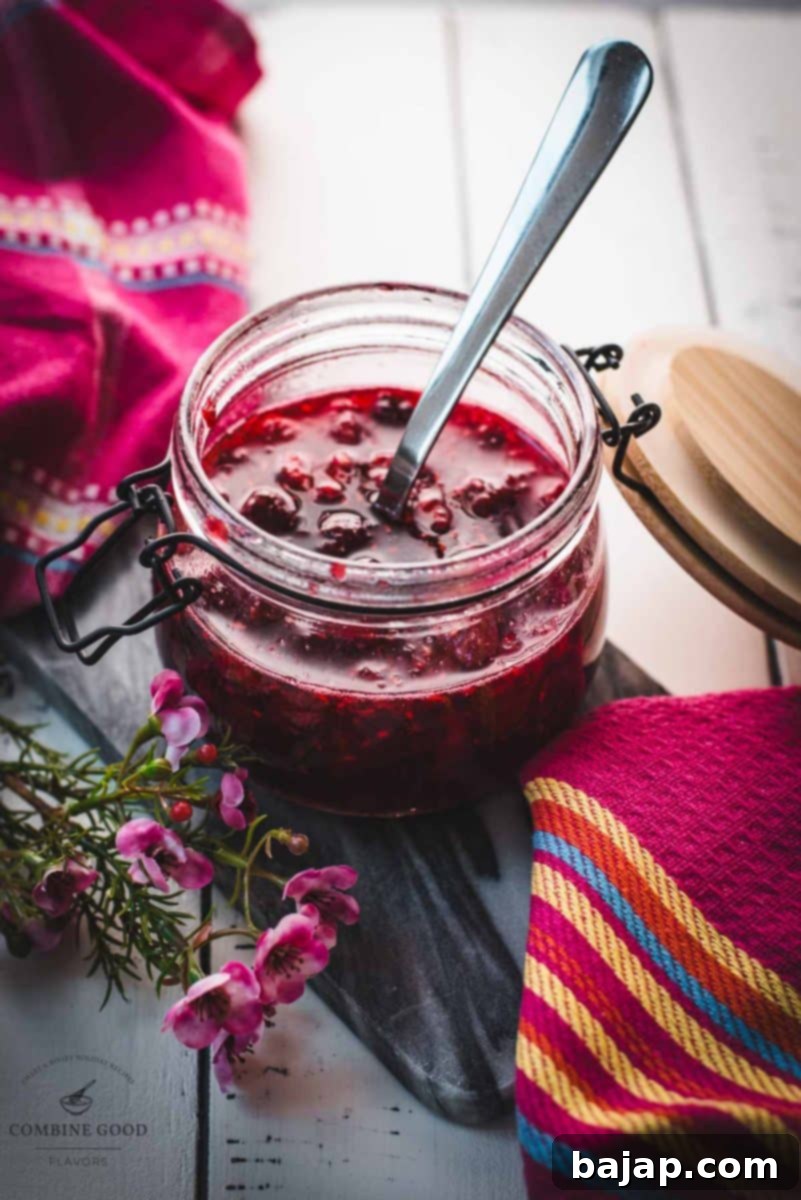
💭 Top Tips & Food Safety
How to Sterilize Glass Containers for Syrups
To ensure your glass containers are impeccably clean and safe for preserving, sterilization is a crucial step. Start by thoroughly washing your jars, lids, and any bottles in hot, soapy water, then rinse them well. For proper sterilization, immerse them completely in a large pot of simmering (not vigorously boiling) hot water. Let them simmer for a thorough 30-minute cleanse. After this, carefully lift each item out using tongs, allowing excess water to drain, and place them upside down on clean paper towels or a clean kitchen cloth to air dry completely. Ensure they are fully dry before filling.
Why Sterilization is Crucial for Homemade Syrups and Jams
Sterilizing glass containers is absolutely paramount for both food safety and the longevity of your homemade syrups and jams, especially when using a no-cook method like this raspberry syrup recipe. It helps eliminate any harmful bacteria, yeasts, or other microorganisms that may be present on the surfaces of your jars. These microorganisms can cause spoilage, fermentation, or even make your food unsafe to consume. By sterilizing, you create a clean environment that significantly extends the shelf life of your delicious homemade delights, ensuring they remain safe, fresh, and flavorful for an extended period. This simple step prevents contamination and spoilage, giving you peace of mind with every pour.
🙋🏻 Frequently Asked Questions (FAQ)
When properly stored in an airtight container in the refrigerator, homemade no-cook raspberry syrup can last for about 2-3 weeks. Always inspect for any signs of spoilage before use.
To make fruit syrup without cooking, you simply combine fresh fruit (like raspberries) with granulated sugar in a clean, airtight container. Refrigerate the mixture for a few days, shaking daily. The sugar will naturally draw out the fruit juices through osmosis, creating a flavorful syrup. Once infused, strain the fruit solids, and transfer the syrup to a bottle for storage in the fridge.
Yes, you can use frozen raspberries! However, it’s best to thaw them completely before combining them with the sugar. Thawing will release more of their natural juices, helping the syrup-making process along. The texture and color might vary slightly compared to using fresh berries, but the flavor will still be delicious.
Don’t discard that flavorful raspberry pulp! You can use it in several ways: stir it into yogurt or oatmeal, spread it on toast, mix it into muffin or cake batter, or even blend it into smoothies for an extra burst of fruit flavor and fiber. It’s a delicious byproduct!
No-cook syrups are generally thinner than stovetop syrups because they don’t undergo the evaporation process that occurs during cooking. The thickness primarily depends on the fruit’s natural pectin and the ratio of sugar to fruit juice. If you prefer a slightly thicker syrup, you can gently reduce it on the stove after straining, but this would negate the “no-cook” aspect and alter the fresh flavor profile.
Other Delicious Raspberry Recipes for You to Try
If you’re a fan of raspberries, you’ll love these other delightful recipes that highlight the versatile and delicious fruit:
- Raspberry Lemon Drop Martini
- Raspberry Daiquiri
- Raspberry Cheesecake
- Raspberry Almond Thumbprint Cookies
- Raspberry Syrup {quick, stovetop method}
- Raspberry Gin & Tonic
- Raspberry Margarita (coming soon)
- Frozen Raspberry Margarita (coming soon)
- Clover Club (coming soon)
If you make this delightful no-cook raspberry syrup recipe, we’d absolutely love to hear from you! Please let us know how you liked it by giving it a ★★★★★ star rating and leaving a comment below. Your feedback is truly awesome and helps our community grow! You can also sign up for our Newsletter to receive weekly delicious homemade recipes straight to your inbox, or follow us on Pinterest or Instagram. Don’t forget to share your amazing creations with us – just tag me @combinegoodflavors and use the hashtag #combinegoodflavors, so I don’t miss your beautiful work!
📖 Recipe: How to Make No-Cook Raspberry Syrup
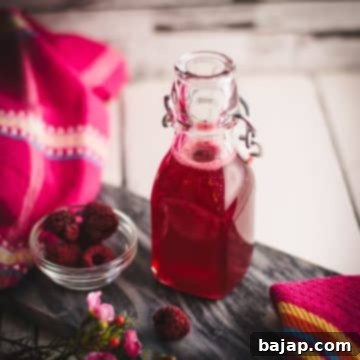
How to make Raspberry Syrup without Cooking
Nora
Save RecipeSaved!
Pin Recipe
Equipment
-
Preserving Jar 10 oz
-
Spoon
-
Close meshed sieve
-
Preserving bottle
-
Funnel
Ingredients
- 1.5 cups Raspberries fresh
- 1.25 cups Granulated sugar
Instructions
-
Fill a clean, sterilized preserving jar with 1.5 cups Raspberries, then layer with 1.25 cups Granulated sugar until the jar is full.1.5 cups Raspberries, 1.25 cups Granulated sugar
-
Close the jar tightly with an airtight lid and refrigerate for 3-5 days to allow the flavors to infuse.
-
Shake the jar gently once or twice every day to help the sugar dissolve and to encourage flavor extraction.
-
Optionally, after a few days, you can gently squeeze the softened raspberries with a spoon to release even more juice and flavor into the syrup.
-
Finally, strain the syrup through a fine-mesh sieve (lined with cheesecloth for a clearer syrup, if desired) to separate the liquid from the fruit solids. Transfer the finished syrup to a clean, airtight bottle for storage in the refrigerator.
Notes
Nutrition values are estimates only, using online calculators. Please verify using your own data.

⛑️ Important Food Safety Guidelines
When preparing any homemade food product, especially those involving fresh ingredients and minimal cooking, adhering to strict food safety practices is paramount. Always ensure your hands, equipment, and workspace are clean to prevent contamination. Here are some general food safety tips to keep in mind:
- Maintain Cleanliness: Always wash your hands thoroughly with soap and warm water before and after handling food, especially raw ingredients.
- Sterilize Containers: As detailed above, ensure all jars and bottles used for storage are properly sterilized to prevent bacterial growth and extend shelf life.
- Use Fresh Ingredients: Opt for the freshest, ripest raspberries available. Inspect them for mold or damage before use.
- Refrigerate Promptly: Keep your syrup refrigerated at all times after preparation to inhibit microbial growth.
- Check for Spoilage: Before consuming, always examine your syrup for any unusual odors, discoloration, or mold, which are signs of spoilage.
- Do Not Leave Food Out: Avoid leaving homemade syrups or any perishable food sitting at room temperature for extended periods.
- Follow Recipe Guidelines: Adhere to recommended infusion and storage times to ensure both safety and optimal flavor.
For further comprehensive information on safe food handling practices, we highly recommend checking resources from reputable organizations like the FDA (Food and Drug Administration).
